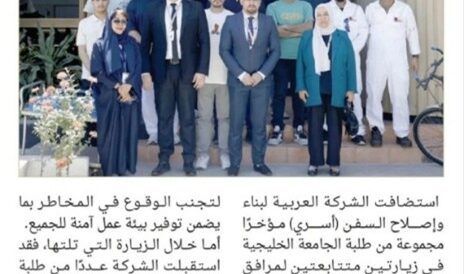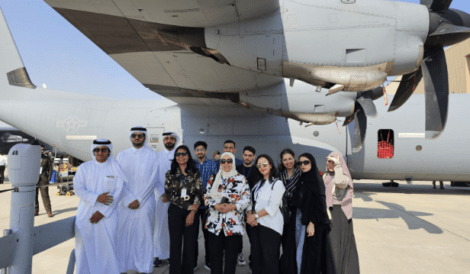The Pearling Path trail stands as a testament to the Kingdom of Bahrain’s millennium-old pearl-collecting history. “Pearling, Testimony of an Island Economy” was designated as the country’s second World Heritage Site in 2012. The regional influences from East Africa, Iraq, the Arabian Peninsula, India, and Persia are seamlessly blended with the regionally influenced styles. Persia is represented in the woodwork of the ceilings and decorative panels; while windows, doors, and their frames were imported via Indian trade routes. Additionally, Arabic culture served as the inspiration for artistic patterns (Pearlingpath.bh, 2024).


Bu Maher Visitor Centre & Sea Shore
Exploring the new architecture was indeed fascinating. Located at the southernmost point of Muharraq, Bu Mahir’s Seashore once stood as a tidal island. It remains the only authentic seashore where celebrations marking the pearling season were held, largely unchanged since the collapse of the pearling economy in the 1930s. Many pearl divers used Bu Mahir Seashore, a sandy point that protrudes into Bahrain’s main harbor, as their last firm surface before starting the main pearling season and as their first landing spot after several months at sea. Since the establishment of the Bu Mahir Visitor’s Centre was built in 2014, the public can once again access Bu Mahir’s Seashore via a water taxi, which connects the center to the Bahrain National Museum. During our visit, we had the opportunity to view models of various buildings along the Pearling Path, offering a comprehensive overview of the entire route.


Bu Maher Fort
Unveiling the Historic Urban & Architectural Landmarks was inspiring; Bu Maher fort, being the first destination. Qal’at Bu Maher was originally a four towered fort with massive defensive walls. Its defensive range covered the narrow channel south-east of Muharraq town, Arad and the passage to Manama.
Pearling Path Visitor Centre
The next destination was the Pearling Path Visitor & Experience Centre representing New Architecture located in the heart of Muharraq, amidst the historic Amarat of the traditional market. Designed by Valerio Olgiati Architects, the project incorporates Amarat Al Doy and its subsequent extension, alongside the remains of Amarat Yousif A. Fakhro, a historic Amarat building constructed in the 1930s that had fallen into disrepair after being unused since the 1960s.
The center, which serves as a community hub, features exhibition spaces, areas for children and workshops, the Pearling Heritage Archive, a library, and conference facilities, appealing to a diverse audience. In addition to housing the Visitor Centre, the building’s unified roof structure is designed to protect the archaeological remains while offering a shaded space for both locals and tourists. The restoration of 15 wind towers enhances the climate beneath the roof. Supported by a forest of slender columns, the roof’s height and the grid of columns create a distinct contrast to the archaeological ruins, with the two systems following different structural logics.
Souq Al Qaysariyah
Exploring the souq offered a distinctive experience of culture, social interaction, and architecture. The market also served as a port for the exchange of products with Bahrain’s main island during the pearling era, prior to the substantial sea reclamation of Muharraq Island’s western coast in the 1960s. Suq AlQaysariyyah played a vital role om the pearling industry, with its cafes where pearl trade took place and functioned as a location for the receipt and storage of wood needed to build the pearling fleets, Suq Al Qaysariyyah was crucial to the pearling business.
Badr Ghulum House
Another interesting stop during the walk was the Badr Ghulum House. In the absence of modern medical services, Badr Ghulum House served as a small health clinic. Members of the pearling community who sought treatment were pearl divers seeking relief from lung, eye and skin diseases (Pearlingpath.bh, 2024).
Siyadi Majlis
It was indeed a breathtaking experience to explore the Siyadi Majlis, observe its traditional architecture, Mashrabeya, Arches, Windows, Patterns, Courtyard and details. We got the opportunity to see the majlis area where gatherings, meetings and important discussions would take place as well as see the private rooms and detailed interiors.


Siyadi Mosque
The mosque consisted of an airy courtyard next to the minaret. The mosque is located adjacent to the Siyadi Majlis. Outside the mosque is also another public square for gathering and socialization.


Public Squares
It was interesting to spot different shaded public squares during our walk in the pearling path trail. The 3.5-kilometer route serves as a link between the Pearling Path’s numerous urban sections and shapes the Pearling Testimony’s narrative, in which each house stands for a different chapter. The squares assist tourists to navigate their walks within the pearling trail. The public areas function as meeting locations for locals and tourists, providing opportunities for relaxation, recreation, and social contact. Several urban elements found during the walk in the squares. Some of them were the signages, urban furniture, number of trees that create a microclimate and offer shade. Every public area is tailored to its specific setting and features various activities including playgrounds, stairs, and kiosk (Pearlingpath.bh, 2024). The trees provided shaded areas where children played, and visitors rested or socialized.
Jamsheer House
As you enter the house, you will find an airy courtyard with greenery. The house was built before the advent of modern technology, a designed to withstand the extreme climate of the area; in the winter, the rooms on the bottom floor remain warm, while the upper floor remains cool during the summer heat. While a wall offers solitude, an open veranda in the middle of the house allows air to circulate. Using solely insulation materials to keep heat out, the walls are composed of gypsum-covered coral, and the high ceilings are made of bamboo. Another distinctive feature of the house is the built-in wall voids that let cool air circulate (Bahrain.com, 2024)


MultiStorey Parking
Lastly, it is significant to mention the Multistorey parking that was built as a part of the project. Christian Kerez planned and built four multistory parking structures in Muharraq. They benefit the community by giving residents free parking spots and charging visitors for parking. Their wide-open buildings provide a fresh urban appeal and give the old city center new characteristics. Every level of the new parking structures in Muharraq offers a unique spatial experience. From above and below, the parking seems like a stack of landscapes. The ramps and slabs are one continuous piece in this drastically redesigned parking facility (Pearlingpath.bh, 2024).
Al Ghus House, Al Jalahma House, Murad House, Al Alawi House, Fakhroo House, ‘Amārat Yousif A. Fakhro, ‘Amārat Ali Rashed Fakhro I, Nūkhidhah House are significant landmarks within the Pearling Path Trail as well. The pearling path trail stands as a testament of Bahrain’s Legacy, Urban Design, Cultural Exchange and a blend of Architectural Styles of different regions.
References:
The pearling path in detail (no date) Pearling path. Available at: https://pearlingpath.bh/en/the-pearling-path-in-detail/#path (Accessed: 04 December 2024).
Bahrain.com (2024). Bahrain.com. [online] Bahrain.com. Available at: https://bahrain.com/en/explore-more-item/9 [Accessed 4 Dec. 2024].




